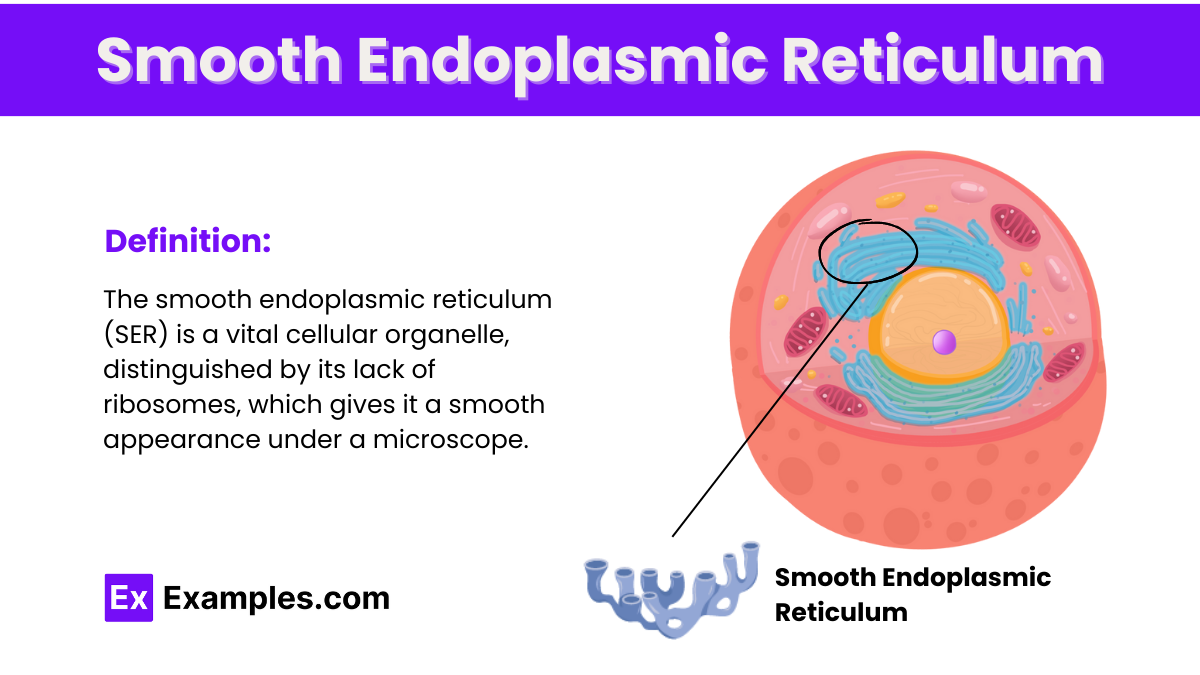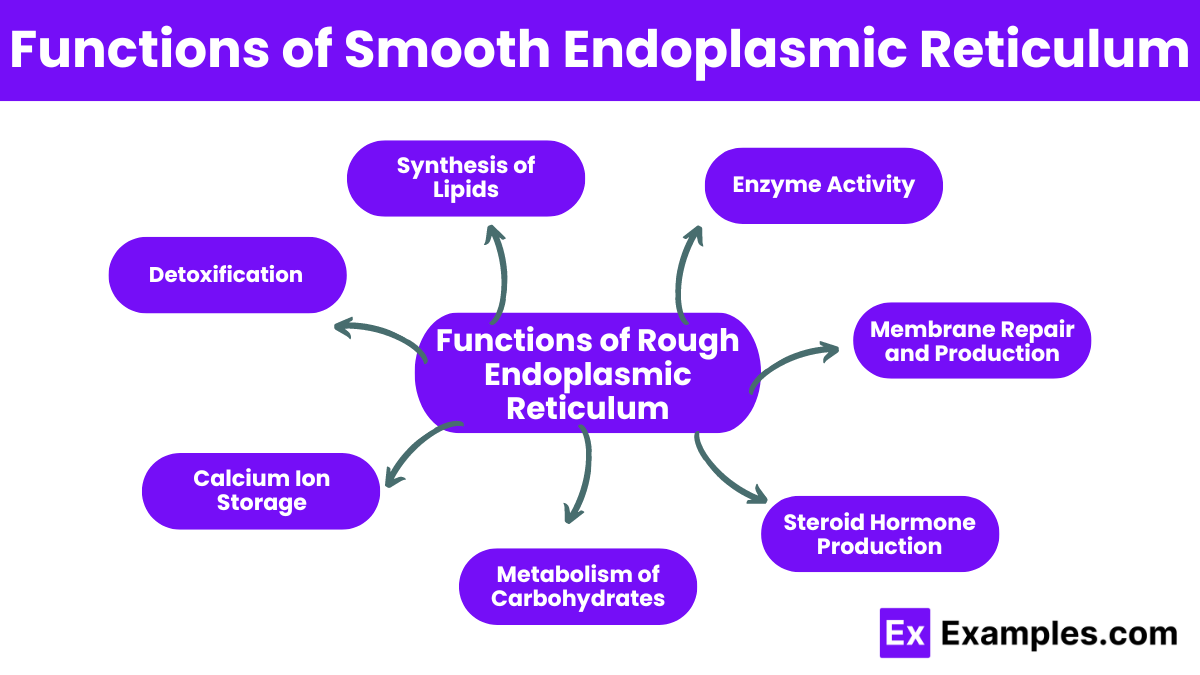What is the primary function of the smooth endoplasmic reticulum (SER)?
Protein synthesis
Lipid synthesis and metabolism
Energy production
DNA replication


The smooth endoplasmic reticulum (SER) plays a crucial role in various cellular processes, including lipid synthesis, carbohydrate metabolism, and detoxification of drugs and toxins. Unlike its counterpart, the rough endoplasmic reticulum, the SER lacks ribosomes, giving it a smooth appearance under a microscope. This structure is pivotal in cells that perform extensive metabolic activities, such as liver and hormone-producing cells. In this article, we will explore the structure, functions, and importance of the smooth endoplasmic reticulum, shedding light on its critical contributions to cellular health and functionality.
The endoplasmic reticulum (ER) is a vital organelle found in the cells of eukaryotic organisms. It functions as a manufacturing and packaging system, playing a critical role in both the production of proteins and lipids and the maintenance of cellular health. The ER is an extensive network of membranes, forming tubes and sheets that spread throughout the cell, connecting to the nuclear envelope and cell membrane.
The smooth endoplasmic reticulum (smooth ER) is a type of organelle found in both animal and plant cells. It is part of the larger endoplasmic reticulum network, which also includes the rough endoplasmic reticulum. Unlike the rough ER, the smooth ER lacks ribosomes on its surface, which is why it appears smooth under a microscope.
The smooth endoplasmic reticulum (SER) is a crucial organelle in various cellular processes, distinguished by its lack of ribosomes, which gives it a smooth appearance under a microscope. Here are the primary characteristics of the smooth endoplasmic reticulum:

One of the key functions of the smooth endoplasmic reticulum is the synthesis of lipids. This includes phospholipids and cholesterol, which are essential components of cellular membranes. In cells of the liver, SER is instrumental in producing lipoproteins that transport fats around the body.
The smooth endoplasmic reticulum plays a significant role in detoxifying potentially harmful substances. Liver cells, in particular, have extensive amounts of SER, which helps process drugs, toxins, and metabolic by-products. Enzymes located in the SER can modify these substances to be more water-soluble, thus easier to eliminate from the body.
Calcium ion storage is another critical function of the smooth endoplasmic reticulum, especially in muscle cells. The SER acts as a reservoir for calcium ions; these ions are vital for muscle contraction. Upon stimulation, calcium ions are released into the cytoplasm, triggering muscle contraction, and then reabsorbed back into the SER to relax the muscle fibers.
In some cells, the smooth endoplasmic reticulum is involved in carbohydrate metabolism. It helps in the breakdown of stored glycogen in liver cells to glucose, which is then released into the bloodstream to maintain blood sugar levels.
The smooth endoplasmic reticulum is crucial in steroid-producing cells, such as those in the adrenal cortex and gonads. It aids in the synthesis of steroid hormones from cholesterol, which are vital for various physiological processes like stress response and reproductive functions.
The SER has a tubular structure that is distinct from the ribosome-studded surface of the rough endoplasmic reticulum (RER). This structure is composed of a network of membranous tubules and vesicles that are continuous with the RER but are noticeably smoother due to the absence of ribosomes. These tubules often extend throughout the cytoplasm, forming an interconnected network that varies in shape and size depending on the cell type and metabolic activity.
The membrane of the SER is similar to that of other cellular membranes, consisting of a phospholipid bilayer. This bilayer is embedded with various proteins that facilitate the functions of the SER, including enzymes involved in lipid and steroid hormone synthesis. The fluidity of the membrane allows for the organelle’s flexibility and dynamic nature, adapting its shape and function according to the cell’s needs.
The internal space, or lumen, of the SER is the site of synthesis for lipids and other molecules. This space is isolated from the cytosol by the phospholipid membrane, creating a distinct internal environment that is crucial for specific enzymatic reactions.
The SER is not uniform in structure throughout the cell. In certain cells, like liver hepatocytes, it appears more extensive and interconnected to cope with its high metabolic functions, including detoxification. In steroidogenic cells, such as those in the adrenal cortex, the SER is involved in the synthesis of steroid hormones and thus is abundant and well-developed.
The distribution of the SER within a cell also varies. In muscle cells, it is specialized into a form known as the sarcoplasmic reticulum, which plays a critical role in the regulation of calcium ions. In neurons, the smooth endoplasmic reticulum contributes to the formation of the axonal membrane and synaptic vesicles.
The SER is most abundantly found in cells that perform specialized metabolic processes. For example, in liver cells, it plays a critical role in detoxifying substances, while in muscle cells, it is crucial for muscle contraction by regulating calcium levels. In steroid hormone-producing cells, such as those in the adrenal cortex and gonads, the smooth endoplasmic reticulum is extensive, reflecting its role in synthesizing lipids and steroids.
The SER is an interconnected network of tubular structures and vesicles. It is often found extending from the rough endoplasmic reticulum, weaving through the cytoplasm. Its structure is highly dynamic and can change based on the cell’s metabolic needs.
In plant cells, the smooth endoplasmic reticulum forms a network of tubular membranes spreading throughout the cytoplasm. It is often found adjacent to the rough ER and can sometimes be continuous with it. The SER’s structure allows it to function efficiently in the synthesis and transport of lipids and other molecules within the cell.
FAQ’s
The smooth endoplasmic reticulum synthesizes lipids, metabolizes carbohydrates, detoxifies chemicals, and stores calcium ions.
The smooth endoplasmic reticulum lacks ribosomes, making it key for lipid synthesis, whereas the rough has ribosomes for protein synthesis.
The endoplasmic reticulum manufactures, processes, and transports chemical compounds for use inside and outside of the cell.
The main function of the smooth endoplasmic reticulum is lipid and steroid hormone synthesis, detoxifying metabolites, and regulating calcium levels.
The smooth endoplasmic reticulum is responsible for lipid production, detoxification, and calcium ion storage, supporting cellular health.
Text prompt
Add Tone
10 Examples of Public speaking
20 Examples of Gas lighting
What is the primary function of the smooth endoplasmic reticulum (SER)?
Protein synthesis
Lipid synthesis and metabolism
Energy production
DNA replication
Which type of cells is likely to have a well-developed smooth endoplasmic reticulum?
Muscle cells
Neurons
Liver cells
Epithelial cells
How does the smooth endoplasmic reticulum differ from the rough endoplasmic reticulum?
The smooth ER has ribosomes attached, while the rough ER does not
The smooth ER is involved in protein synthesis, while the rough ER is no
The rough ER has ribosomes attached, while the smooth ER does not
The smooth ER is found only in plant cells, while the rough ER is in animal cells
What role does the smooth endoplasmic reticulum play in detoxification?
It modifies proteins for exocytosis
It synthesizes ATP for energy
It synthesizes ATP for energy
It stores calcium ions for muscle contraction
Which of the following substances is synthesized in the smooth endoplasmic reticulum?
Insulin
Steroid hormones
Hemoglobin
Antibodies
What is the significance of calcium ion storage in the smooth endoplasmic reticulum?
It provides energy for cellular processes
It regulates muscle contractions and signaling pathways
It aids in protein folding
It assists in DNA synthesis
In which type of tissue would you expect to find a high concentration of smooth endoplasmic reticulum?
Nervous tissue
Adipose tissue
Epithelial tissue
Connective tissue
How does the smooth endoplasmic reticulum contribute to lipid metabolism?
By breaking down carbohydrates
By synthesizing triglycerides and phospholipids
By storing glycogen
By producing ATP
Which of the following processes is NOT associated with the smooth endoplasmic reticulum?
Lipid synthesis
Drug detoxification
Protein synthesis
Calcium storage
What happens to the smooth endoplasmic reticulum during liver cell proliferation?
It decreases in size
It remains unchanged
It increases in size and enzyme content
It transforms into rough endoplasmic reticulum
Before you leave, take our quick quiz to enhance your learning!

